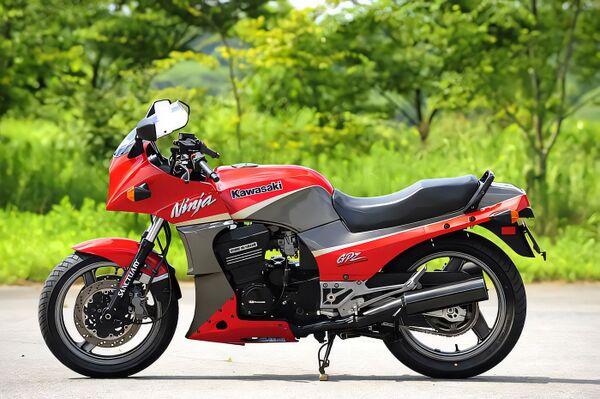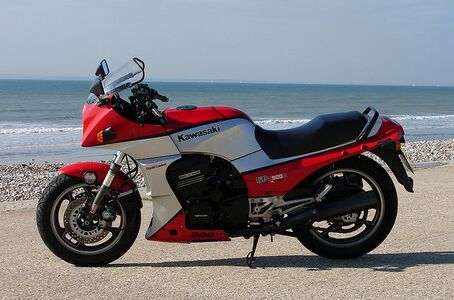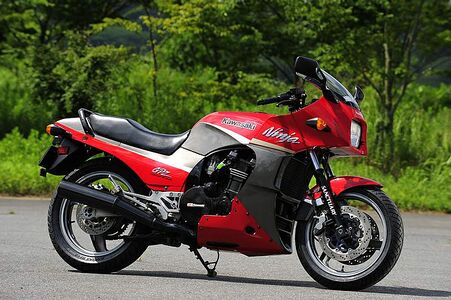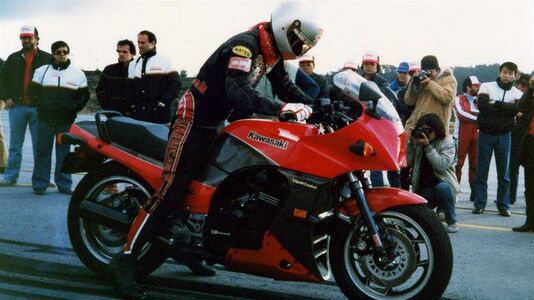Difference between revisions of "Kawasaki GPZ900"
m |
m |
||
| (One intermediate revision by the same user not shown) | |||
| Line 1: | Line 1: | ||
{{DISPLAYTITLE: Kawasaki GPZ900R (GPZ 900, ZX900A, Ninja 900)}} | {{DISPLAYTITLE: Kawasaki GPZ900R (GPZ 900, ZX900A, Ninja 900)}} | ||
| + | {{#seo: | ||
| + | |keywords={{PAGENAME}}, review, specs, owners manual, service manual, guide | ||
| + | |og:image=https://en.enduro.team/images/8/82/Kawasaki_GPZ900R_98_1.jpg | ||
| + | }} | ||
__notoc__ | __notoc__ | ||
| − | [[file: Kawasaki GPZ900R 98 1.jpg | | + | [[file: Kawasaki GPZ900R 98 1.jpg | 600px | center | Kawasaki GPZ 900]] |
| − | The legendary Kawasaki GPZ900R sports bike was first introduced in 1984 and is the earliest Kawasaki sports bike. In those years, the motorcycle was distinguished by an innovative appearance, but the most notable was its engine - an in-line 4-cylinder liquid-cooled block with a volume of 908 cc. see, gave out fantastic at that time 115 hp, accelerating the motorcycle to 243 km / h, which was a record among mass-produced road bikes. In the North American market, this motorcycle is called | + | The legendary Kawasaki GPZ900R sports bike was first introduced in 1984 and is the earliest Kawasaki sports bike. In those years, the motorcycle was distinguished by an innovative appearance, but the most notable was its engine - an in-line 4-cylinder liquid-cooled block with a volume of 908 cc. see, gave out fantastic at that time 115 hp, accelerating the motorcycle to 243 km / h, which was a record among mass-produced road bikes. In the North American market, this motorcycle is called ''' Kawasaki Ninja 900 '''. |
{{Ads_top}} | {{Ads_top}} | ||
| − | |||
| − | |||
| − | |||
| − | + | ''' Lineup:''': | |
| − | * | + | * [[Kawasaki_GPZ400 | Kawasaki GPZ 400]] |
| − | * | + | * [[Kawasaki_GPZ500 | Kawasaki GPZ 500]] |
| + | * [[Kawasaki_GPZ600 | Kawasaki GPZ 600]] | ||
| + | * [[Kawasaki_GPZ750_Turbo | Kawasaki GPZ 750 Turbo]] | ||
| + | * [[Kawasaki_GPZ900 | Kawasaki GPZ 900]] | ||
| + | * [[Kawasaki_GPZ1100 | Kawasaki GPZ 1100]] | ||
| − | '' | + | ''' Main competitors: ''' |
* [[Yamaha_XJ900S_Diversion | Yamaha XJ 900 S Diversion]] | * [[Yamaha_XJ900S_Diversion | Yamaha XJ 900 S Diversion]] | ||
| + | |||
| + | The Kawasaki GPZ900R also led to a significant breakthrough for Japanese motorcycles in the Superbike class. Despite the standard technical features in those years - a steel frame, 16- and 18-inch wheels, air suspension, etc., the motorcycle had not only outstanding dynamic characteristics, but also excellent steering. The reason for this was the special arrangement of the engine, which "sat" in the frame a little lower, thereby lowering the center of gravity. | ||
| + | [[File: 194449-13330-70-pristine.jpg | 500px | center | Kawasaki GPZ 900]] | ||
| + | |||
| + | In 1986, Kawasaki released the new GPZ1000RX to replace the GPZ900R, but both continued to be produced in parallel. And even the release of [[Kawasaki_ZZR1100 | Kawasaki ZZ-R1100]] (in 1990) did not fundamentally change the situation - the Kawasaki GPZ 900 continued to be produced and sold in Europe until 1993 inclusive. In 1998, the motorcycle production was moved to Malaysia, from where the model went to the domestic Japanese market (and some Asian countries). It was only in 2003 that the production of the Kawasaki GPZ900R was finally stopped. | ||
== Photos == | == Photos == | ||
| − | + | <gallery mode="packed" heights=200px> | |
| − | + | File:8076590493 fff2397a19 z.jpg| | |
| − | + | File:Gpz-900r-ninja 1997 1.jpg| | |
| − | + | File:55eb2d9a25de49e04bbcdd307ac18801.jpg| | |
| − | + | </gallery> | |
| − | |||
{{Ads_feed}} | {{Ads_feed}} | ||
{{Ads_post}} | {{Ads_post}} | ||
Latest revision as of 14:04, 28 June 2023
The legendary Kawasaki GPZ900R sports bike was first introduced in 1984 and is the earliest Kawasaki sports bike. In those years, the motorcycle was distinguished by an innovative appearance, but the most notable was its engine - an in-line 4-cylinder liquid-cooled block with a volume of 908 cc. see, gave out fantastic at that time 115 hp, accelerating the motorcycle to 243 km / h, which was a record among mass-produced road bikes. In the North American market, this motorcycle is called Kawasaki Ninja 900 .
Lineup::
- Kawasaki GPZ 400
- Kawasaki GPZ 500
- Kawasaki GPZ 600
- Kawasaki GPZ 750 Turbo
- Kawasaki GPZ 900
- Kawasaki GPZ 1100
Main competitors:
The Kawasaki GPZ900R also led to a significant breakthrough for Japanese motorcycles in the Superbike class. Despite the standard technical features in those years - a steel frame, 16- and 18-inch wheels, air suspension, etc., the motorcycle had not only outstanding dynamic characteristics, but also excellent steering. The reason for this was the special arrangement of the engine, which "sat" in the frame a little lower, thereby lowering the center of gravity.
In 1986, Kawasaki released the new GPZ1000RX to replace the GPZ900R, but both continued to be produced in parallel. And even the release of Kawasaki ZZ-R1100 (in 1990) did not fundamentally change the situation - the Kawasaki GPZ 900 continued to be produced and sold in Europe until 1993 inclusive. In 1998, the motorcycle production was moved to Malaysia, from where the model went to the domestic Japanese market (and some Asian countries). It was only in 2003 that the production of the Kawasaki GPZ900R was finally stopped.
Photos
Specifications
Specifications Kawasaki GPZ900R:
| Model | Kawasaki GPZ900R (Ninja 900, ZX900A) |
|---|---|
| Motorcycle type | sports tourist |
| Release year | 1984-2003 |
| Frame | steel |
| Engine type | 4-cylinder, 4-stroke, in-line |
| Working volume | 908 cc cm. |
| Bore / Stroke | 72.5 x 55.0mm |
| Compression ratio | 11.0: 1 |
| Cooling | liquid |
| Number of valves per cylinder | DOHC, 4 valves per cylinder |
| Fuel supply system | Carburetor, 4x Keihin CVK34 |
| Ignition type | transistor |
| Maximum power | 115.0 h.p. (84.6 kW) @ 9500 rpm - Max. ZX900-A1 ~ A6
108 h.p. (79.4 kW) - Max. ZX900-A7 + 110.0 h.p. (80.9 kW) @ 9500 rpm - ZX900-A3 ~ A6 (US) 100.0 h.p. (73.5 kW) - ZX900 (Germany, France) 86 h.p. (63.2 kW) @ 9000 rpm - ZX900A8-A16 (Japan) |
| Maximum torque | 85.3 Nm (8.7 kgf * m) @ 5000 rpm - Max.
72 Nm (7.3 kgf * m) @ 6500 rpm - ZX900A8-A16 (Japan) |
| Gearbox | 6-speed |
| Drive type | chain |
| Front tire size | 120 / 80-16 - ZX900-A1 ~ A6
120 / 70-17 - ZX900-A7 ~ A16 |
| Rear tire size | 130 / 80-18 - ZX900-A1 ~ A6
150 / 70-18 - ZX900-A7 ~ A16 |
| Front brakes | 2 discs, 280mm, 1-piston calipers - ZX900-A1 ~ A6
2 discs, 300mm, 4-piston calipers - ZX900-A7 ~ A11 2 discs, 300mm, 6-piston calipers - ZX900-A12 ~ A16 |
| Rear brakes | 1 disc, 270mm, 1-piston caliper - ZX900-A1 ~ A6
Single disc, 250mm, 2-piston caliper - ZX900-A7 ~ A16 |
| Front suspension | 38mm Telescopic Fork, 140mm Travel - ZX900-A1 ~ A6
41mm Telescopic Fork (Anti-Dive), 140mm Travel - ZX900-A7 ~ A16 |
| Rear suspension | linkage with monoshock, stroke - 115 mm |
| Dimensions (L x W x H) | 2200 x 750 x 1215 mm |
| Wheelbase | 1495 mm |
| Saddle height | 780 mm |
| Acceleration to 100 km / h | 3.8 sec |
| Maximum speed | 243 km / h
180 km / h - Japanese versions (since 1991) |
| Fuel tank capacity | 22.0 l (including reserve - 4.0 l) |
| Motorcycle weight (dry) | 228 kg - ZX900-A1 ~ A6
234 kg - ZX900-A7 ~ A16 |
| Motorcycle weight (curb) | 249 kg - ZX900-A1 ~ A6
255 kg - ZX900-A7 ~ A16 |
Documentation




